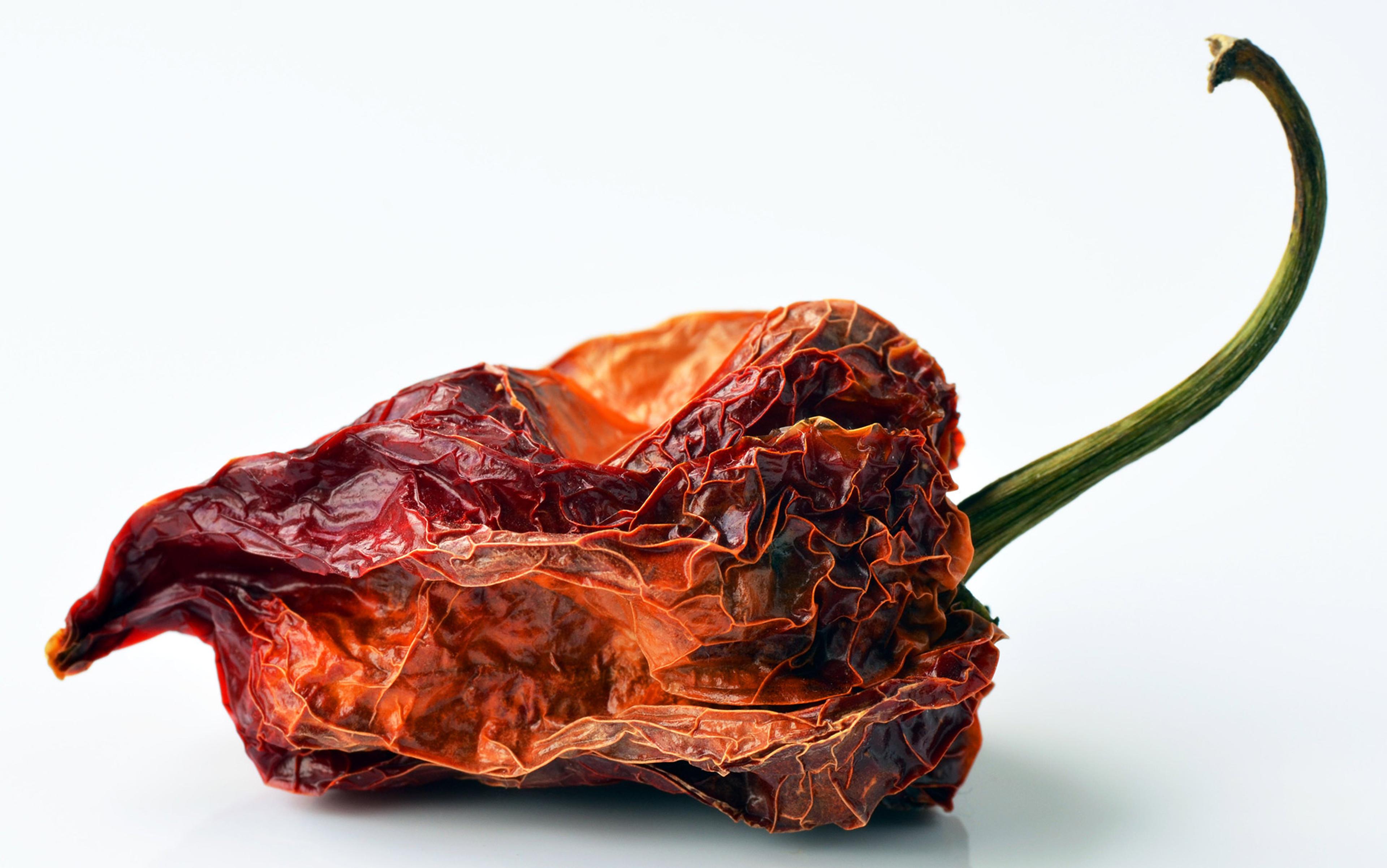On drizzly gray Sundays, after a mid-morning stroll has left my bones damp, I nestle under the covers and curl into a ball. Laptop on bedspread, I wrap myself in the screen’s azure glow and scroll through images of the vox populi in search of warmth, flavour and spice. In short, I spend hours watching YouTube videos of people eating chili peppers.
The standard form is this: the vlogger, glass of milk within easy reach, holds a single dried pepper pod to the camera, before taking a deep preparatory breath and gingerly placing it in their mouth. The chili being consumed is usually brown, the size of a shrunken peach pit. It looks harmless enough. Yet whether it’s a ghost pepper, a naga viper, a trinidad moruga scorpion or a carolina reaper, it’s almost always one of the world’s hottest chilis. It will have busted the once-mythical limit of 1 million Scoville Heat Units (SHU) – the curious measure developed in 1912 by Wilbur Scoville, an American pharmacist.
Scoville would take a measured amount of dried pepper and make an alcohol extraction of its capsaicin oil (capsaicin gives chili peppers their bite). That extraction would be added incrementally to a sugar-water solution, until an assembled panel of five tasters could no longer detect the pepper’s heat. A measurement of 1.5 SHU is roughly equivalent to one part per million of chili heat. These days, high-performance liquid chromatography adds a heightened level of precision, but the basic principle remains the same. Your standard bell pepper has a Scoville rating of zero; the common jalapeño, 10,000 SHU; a habanero around 300,000 SHU.
The peppers that the YouTubers love to eat are all roughly 100 times hotter than a jalapeño. The bhut jolokia, or ghost pepper, from northeast India, was officially the first pepper to hit 1 million SHU early this century. Seven additional peppers have since broken the 1 million SHU barrier; the hottest, the carolina reaper, at 2.2 million SHU, is poised this year to be supplanted by HP56, a pepper that registers 3 million SHU. It was developed, as peppers usually are, through standard hybridisation techniques. And what can’t be accomplished through horticulture can be achieved through cookery: hot sauces sold to so-called ‘pepperheads’ can hit 16 million SHU.
While I don’t remember the first time I tasted a chili pepper (I’m fairly certain my mother slipped some in my baby bottle – at least, my taste for it was early acquired), I do remember the first time I couldn’t have it: on a high-school exchange in Nicaragua. Central American cuisine, though delicious, is not especially spicy, and unlike Hillary Clinton I’d failed to pack hot sauce. Toiling through my nacatamales, vigorón and gallo pinto, I longed for a touch of a scotch bonnet, a sprinkling of jalapeño.
On YouTube, the pepperhead – a gangly 12-year-old with Harry Potter glasses, a 20-something woman in a cat T-shirt, or a bro in a backwards baseball cap – begins to chew. There’s a pause as the brain registers the sensation, then an eruption of expletives, tears, occasionally vomiting. The milk, a supposed tempering agent, never works, whether it’s chugged, swirled around like mouthwash, or poured over the body. ‘It tastes like a thousand burning needles in my mouth,’ exclaims the pepperhead, before losing the ability to speak altogether.
Why would anyone do this to themselves?
Chili peppers (Capsicum annuum) which bear no relation to black pepper (Piper nigrum) have been spicing up Mexican food since at least 7500 BCE. India might now be a sizeable exporter of the world’s chili peppers, but these peppers did not exist outside Central East Mexico (an area that includes modern New Mexico) before the ‘discovery of the Americas’. The Columbian Exchange, the post-1492 exchange of plants and animals between the Old World and New for the first time after millions of years of separation, sent chili peppers skittering across the globe in an early culinary fusion. Today’s Eastern varietals are descendants of those early North American peppers.
Why a product with all the bite but none of the power of, say, gun powder, would make it into the daily meals of people living in countries as diverse as Ethiopia, Bangladesh and Fiji has long left psychology researchers with blander palates scratching their heads. Capsaicin, which incidentally is a vanilloid (a group that includes the compounds that give vanilla its sweet aroma), works by binding to a receptor on the cells that detect temperature and, separately, to cells that signal pain. Piperine, the compound that gives black pepper its bite, and allyl isothiocynanate, the chemical that gives mustard and radishes (including wasabi) their kick, work on similar receptors. We register chili as hot because those receptors, VR1, are usually triggered only by putting foods hotter than 110°F (43°C) into our mouths or by coating them with acid.
The cookery writer Julia Child once claimed that eating too many chilis could burn off your taste buds. It can’t. But sometimes eating chili or, worse, rubbing your eyes or your nethers with capsaicin-coated hands, can make you wish it would sear off your pain receptors.
Peppers likely developed capsaicin to keep mammals – with our flat, seed-destroying teeth – away from the fruit. Sweet peppers, it’s thought, hope to dissuade by mimicry: if they look enough like hot peppers, mammals won’t risk eating them. Birds, which generally lack teeth and allow the seeds to pass through their digestive tract intact, can’t detect capsaicin and thus can easily eat chili peppers. This allows for wide dispersal as the birds release the seeds when they defecate.
Mostly this investment in capsaicin seems to have worked. Paul Bosland, director of the Chile Pepper Institute at New Mexico State University which breeds and researches chili peppers, told me that mice will avoid eating chili peppers if they have other options. Paul Rozin, a professor of psychology at the University of Pennsylvania, who has studied dogs in Mexico that are frequently fed the chili-infused leftovers of their human owners, has observed the same thing. I don’t believe, however, that the pepper fully anticipated Homo sapiens. As someone who has eaten rotted fermented shark, durian fruit with its redolent gasoline-like aroma, and the slimy mass of eyes and tentacles that comprise conch, I’m unsure what manner of beast or botanic we humans would be unwilling to eat. And yet, even through this lens, our tolerance of chili peppers is unique.
According to Rozin, disgust is ‘acquired’. We learn to hate decaying foods, ‘odd meats’ or stinky things. It’s why many cultures tolerate spoiled milk in the form of cheese, but not in the clotted form it takes when aged in a milk carton at the back of a fridge. It’s also why many Asian cultures view both cheese and spoiled milk with disgust: they have not crafted a cheese exception. On the other hand, we don’t have to learn that irritating foods – such as chili peppers – should be spit out. Young children below the age of five generally dislike chili peppers. We have to learn to like them.
the body’s natural processes trigger internal opiates in the face of pain: chili-pepper eaters are essentially drugging themselves
Why so many of us willingly eat a food that elicits a sensation akin to poking our tongue into a fire is a curious question. As a rule, people in hotter countries, or hotter parts of the same country, consume more chili than those in cooler climes: in the United States, Louisiana’s jambalaya is spicy, while New England’s clam chowder is not. Food can be preserved in cold climates just by leaving it outdoors, in nature’s refrigerator, but hotter climates require more extreme methods. Chili peppers, powered by antimicrobials, kill many of the microbes that spoil food in warmer climates. Over time, people learned that foods laced with chili peppers were less likely to send them running to the toilet. Though, in many people, capsaicin causes ‘a ring of fire’ as it exits the anal sphincter, so chili peppers, in effect, substitute one sort of violent eruption for another.
While chili peppers are antimicrobial, garlic, onion, oregano, cloves and even the demure bay leaf all pack a stronger microbe-killing punch, and also go easier on the tongue. And most of these spices are also found in chili-containing cuisines. Similarly, chili’s absence in colder climates is easily explained by the fact that they’re warm-weather plants that evolved in desert climates. Throw them into cooler climates, or put a little too much nitrogen in their soil, and you’ll get a very lovely pepper plant – but no fruit. Perhaps most critically, as our YouTube brethren show, chili pepper consumption has not declined with the advent of refrigeration – it’s increased. Since 2000, hot-sauce consumption in the US rose by 150 per cent.
In my case, something almost magical happens when I bite into a chili-spiced dish. There’s the release of heat, a rising cascade of pain, but with it comes a forced awareness of my body. My nostrils clear, I start to sweat a little, and I develop a laser-like focus on what’s going on inside of my mouth: flavours become more intense. Most significantly, the body’s natural processes trigger internal opiates in the face of pain, which suggests that chili-pepper eaters are essentially drugging themselves.
There’s a macho, mostly male, do-or-die culture around eating the world’s hottest peppers. Adam Richman, the likeable host of the US TV show Man v Food, routinely undertook ‘heat challenges’, subjecting himself to the most spicy foods. In November 2012, the chef Arif Ali passed out and was hospitalised after eating chicken wings prepared in a sauce containing bhut jolokia chilis for a Man v Food-style challenge at a restaurant in London. In England, the Clifton Chilli Club chili-eating contest features 17 rounds in which participants take on increasingly hotter peppers. Similar competitions exist in Nagaland, India (homeland of the bhut jolokia) as well as in Scotland, Thailand and the US. The habitual eating of chilis renders other foods bland, which is why pepperheads need ever hotter varieties to get the same kick, routinely consuming peppers that would leave the rest of us drenched in sweat.
Machismo aside, most people don’t chase the higher kick – we get to like a higher level of heat, but then stay there. Also, we don’t experience withdrawal symptoms. Rozin says that the chili pepper ‘doesn’t have the usual addictive properties’: you might miss its heat, but you can function without it. In this sense, chilis are only as corrupting to the palate as salt or sugar. Most importantly, animals share similar biological symptoms and get addicted to the same drugs we get addicted to. If humans were becoming addicted to chili peppers, ‘then the animals in Mexico would also like it, because they have that system and they eat hot peppers all the time,’ says Rozin. ‘But they don’t like it which makes me think that there’s something more human about it.’
If you enjoy the bitterness of tobacco, coffee or dark chocolate, a good cry over a sad movie, or a good scream at a horror flick: that’s benign masochism
Rozin thinks that our ability to enjoy experiences that logic says we shouldn’t is an example of a hedonic reversal – the word hedonic coming from the Ancient Greek hēdonikos, meaning pleasure. But the term I prefer is benign masochism. It’s a definition that Rozin extends to a number of human pleasures: for example, sky diving and rollercoaster riding. If you enjoy the bitterness of tobacco, coffee or dark chocolate, that’s benign masochism. If your idea of a swell time is a good cry over a sad movie, or a good scream at a horror flick, that too is benign masochism. It embraces a level of meta-awareness: you feel the pain, but with the distance of knowing it’s not truly harmful. It is a form of enjoying mind over body.
As far as we know, hedonic reversal is a distinctly human form of enjoyment, related in part to the fact that feelings of aversion and pleasure overlap closely in our brains, releasing similar, upbeat, chemical payloads. People who enjoy chili peppers also tend to be more sensation-seeking – though not as much as people who are into fear.
Why we enjoy watching people eat chilis is another matter. Rozin again: ‘When you watch a horror movie, you’re really scared. It’s not quite the same in this case. But you’d have to feel, get some signal yourself, that there’s something negative.’ Perhaps it’s a case of ‘projected benign masochism’ or ‘benign sadism’. Either way, given danger without harm, gained for a handful of change in the comfort of your own kitchen, my response to the question of why anyone would eat a chili pepper is: why would anyone not?






